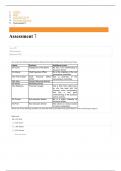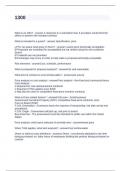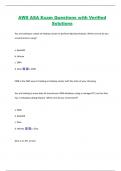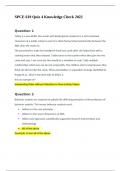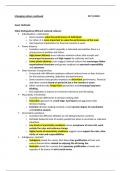Summary Strategy
Lecture 1 (30-01-23)
Introduction
Strategy is about dilemmas and paradoxes
- Understanding the assignment
- Identifying the strategic issues
Two ways of viewing strategic questions:
1. Tools-driven (SWOT, PESTL, BCG)
2. Problem-driven
Problem-driven approach used. Key strategic issues are identified and examined
from the perspective of the most appropriate theories
What is strategy about?
- Strategizing: cognitive processes of individual strategists
- Missioning and visioning: purpose of the impetus for strategy activities
- Strategy process: the manner in which strategies come about
- Strategy content: combined decisions and choices that lead a company into
the future
- Strategy context: set of circumstances under which the strategy content and
the strategy process are determined
Dimensions of strategy and the organizational purpose:
Strategy tensions as
puzzles, dilemmas, trade-offs,
and paradoxes
,What is strategy about?
A paradox has no answer or set of answers
6 different ways of dealing with a paradox
- Navigating: focus on one contrary element at a time (seeking synergies, then
looking for responsiveness)
- Parallel processing: separate the contrary demands in different internal or
external organizational units (improving existing products, meanwhile
developing new generations of products)
- Balancing: trade off elements of the opposing demands (following industry
rules vs. changing others)
- Juxtaposing: managing opposite demands (competing and collaborating)
- Resolving: develop a new synthesis between competing demands
- Embracing: embrace and actively use the tension as a source of creativity and
opportunity
Lecture 2 (02-02-23)
Missioning and visioning
Defining organizations:
What do we mean by an organization?
- An organization is an association of productive assets (including people) who
voluntarily come together to accomplish a set of goals
- In the case of the business organization this goal means gaining an economic
advantage
- For these productive assets to come together to occur it must be worth it for
people and others to be involved with the organization
Ronald Coase (1910-2013): why firms exist
- The cost of using the price system, came to be called transaction costs
- The main reason why it is profitable to establish a firm would seem to be that
there is a cost of using the price mechanism
- The size o the firm is not its output (Q) but the number of transactions or
activities within its boundaries
- Firms exist in order to economize on buying and selling everything
- Firms exist to reduce transaction costs
Existence of Firm (1972):
- Firms are formed when benefits can be obtained from individuals working as a
team
- Sometimes the sum of what individuals can produce as a team is greater than
the sum of what they can produce alone
- Why doesn’t the firm expand forever?
Functions of corporate mission:
Direction
Legitimization
Motivation
,Corporate mission elements:
Elements of strategic vision:
- Envisioned contextual environment
- Envisioned industry environment
- Desired future organizational position
- Time horizon
, Corporate mission and strategic mission:
- Corporate mission outlines the fundamental principles guiding strategic
choices
- Strategic vision outlines the desired future at which the company hopes to
arrive
- The corporate mission and strategic vison together send the firm in a
particular direction
‘’Failure comes only when we forget our ideals and objectives and principles.’’
- Jawaharlal Nehru (1889-1964), First Prime Minister of India
Corporate governance:
Functions of corporate governance
- Forming function
- Performance function
- Conformance function
Forms of corporate governance
- Board structure two-tier or one-tier
- Board membership composition of the board
- Board tasks tasks and authority of the board may vary
Two-tier board:
Consists of 2 types of boards
- Executives: management board (headed by CEO)
- Non-executives: supervisory board (headed by chairperson)
One-tier board:
board of directors includes chairperson, CEO and other executive directors
What is performance?
An important question in the study of firms
- For firm’s it’s when the company successfully formulates and implements a
value-creating strategy
Managing the paradox of profitability and responsibility:
‘’A business that makes nothing but money is a poor kind of business.’’
- Henry Ford (1863-1947), American Industrialist
Profitability and responsibility dealing with the paradox
Profitability:
- To be an attractive investment, a firm must earn a higher return on the
shareholders’ equity than they could be getting at a bank.
Responsibility:
- Acting in the interest of others, even when there is no legal imperative
Managing the paradox of profitability and responsibility:
- Companies that produce products in low-wage countries have been accused
of using child labour or unsafe working conditions
Unilever Plans thousands of job cuts as Peltz builds stake:
- CEO Jope faces rising pressure to boost share performance
- Move follows failed bids for Glaxo’s healthcare business
Lecture 1 (30-01-23)
Introduction
Strategy is about dilemmas and paradoxes
- Understanding the assignment
- Identifying the strategic issues
Two ways of viewing strategic questions:
1. Tools-driven (SWOT, PESTL, BCG)
2. Problem-driven
Problem-driven approach used. Key strategic issues are identified and examined
from the perspective of the most appropriate theories
What is strategy about?
- Strategizing: cognitive processes of individual strategists
- Missioning and visioning: purpose of the impetus for strategy activities
- Strategy process: the manner in which strategies come about
- Strategy content: combined decisions and choices that lead a company into
the future
- Strategy context: set of circumstances under which the strategy content and
the strategy process are determined
Dimensions of strategy and the organizational purpose:
Strategy tensions as
puzzles, dilemmas, trade-offs,
and paradoxes
,What is strategy about?
A paradox has no answer or set of answers
6 different ways of dealing with a paradox
- Navigating: focus on one contrary element at a time (seeking synergies, then
looking for responsiveness)
- Parallel processing: separate the contrary demands in different internal or
external organizational units (improving existing products, meanwhile
developing new generations of products)
- Balancing: trade off elements of the opposing demands (following industry
rules vs. changing others)
- Juxtaposing: managing opposite demands (competing and collaborating)
- Resolving: develop a new synthesis between competing demands
- Embracing: embrace and actively use the tension as a source of creativity and
opportunity
Lecture 2 (02-02-23)
Missioning and visioning
Defining organizations:
What do we mean by an organization?
- An organization is an association of productive assets (including people) who
voluntarily come together to accomplish a set of goals
- In the case of the business organization this goal means gaining an economic
advantage
- For these productive assets to come together to occur it must be worth it for
people and others to be involved with the organization
Ronald Coase (1910-2013): why firms exist
- The cost of using the price system, came to be called transaction costs
- The main reason why it is profitable to establish a firm would seem to be that
there is a cost of using the price mechanism
- The size o the firm is not its output (Q) but the number of transactions or
activities within its boundaries
- Firms exist in order to economize on buying and selling everything
- Firms exist to reduce transaction costs
Existence of Firm (1972):
- Firms are formed when benefits can be obtained from individuals working as a
team
- Sometimes the sum of what individuals can produce as a team is greater than
the sum of what they can produce alone
- Why doesn’t the firm expand forever?
Functions of corporate mission:
Direction
Legitimization
Motivation
,Corporate mission elements:
Elements of strategic vision:
- Envisioned contextual environment
- Envisioned industry environment
- Desired future organizational position
- Time horizon
, Corporate mission and strategic mission:
- Corporate mission outlines the fundamental principles guiding strategic
choices
- Strategic vision outlines the desired future at which the company hopes to
arrive
- The corporate mission and strategic vison together send the firm in a
particular direction
‘’Failure comes only when we forget our ideals and objectives and principles.’’
- Jawaharlal Nehru (1889-1964), First Prime Minister of India
Corporate governance:
Functions of corporate governance
- Forming function
- Performance function
- Conformance function
Forms of corporate governance
- Board structure two-tier or one-tier
- Board membership composition of the board
- Board tasks tasks and authority of the board may vary
Two-tier board:
Consists of 2 types of boards
- Executives: management board (headed by CEO)
- Non-executives: supervisory board (headed by chairperson)
One-tier board:
board of directors includes chairperson, CEO and other executive directors
What is performance?
An important question in the study of firms
- For firm’s it’s when the company successfully formulates and implements a
value-creating strategy
Managing the paradox of profitability and responsibility:
‘’A business that makes nothing but money is a poor kind of business.’’
- Henry Ford (1863-1947), American Industrialist
Profitability and responsibility dealing with the paradox
Profitability:
- To be an attractive investment, a firm must earn a higher return on the
shareholders’ equity than they could be getting at a bank.
Responsibility:
- Acting in the interest of others, even when there is no legal imperative
Managing the paradox of profitability and responsibility:
- Companies that produce products in low-wage countries have been accused
of using child labour or unsafe working conditions
Unilever Plans thousands of job cuts as Peltz builds stake:
- CEO Jope faces rising pressure to boost share performance
- Move follows failed bids for Glaxo’s healthcare business


